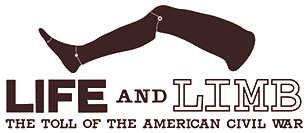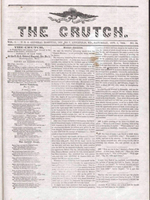
ADDITIONAL RESOURCES
- K-12 additional reading: Civil War Medicine, Veterans, and Disabilities
- Curator's bibliography

K-12 additional readings:
Nonfiction
Barton, Michael, and Larry Logue, eds. The Civil War Veteran: A Historical Reader. New York: New York University, 2007. (Grade levels: 9 and up)
This compilation of essays illustrates the challenging post-Civil War circumstances soldiers faced when returning to civilian life. The essays detail how veterans encountered social, economic, and medical hardships due to few government or private resources, chronic health issues acquired in the war, and a society growing weary of providing the veterans with support.
Freemon, Frank R. Gangrene and Glory: Medical Care during the American Civil War. Chicago: University of Illinois, 2001.; Madison, NJ and London: Fairleigh Dickinson University and Associated University Press, 1998. (Grade levels: 10 and up)
Gangrene and Glory presents the medical history of the Civil War from multiple perspectives: the Union, the Confederacy, doctors, nurses, soldiers, and their families. The closer look at the perspectives, medical techniques, and knowledge of the time provides a historical context from which to understand challenges faced by healthcare practitioners and injured soldiers.
Kuz, Julian E., and Bradley P. Bengston. Orthopaedic Injuries of the Civil War: An Atlas of Orthopeadic Injuries and Treatments During the Civil War. Kennesaw, GA: Kennesaw Mountain Press, 1996. (Grade levels: 11 and up)
Kuz and Bengston’s work offers an anatomical overview of different regions of the body accompanied by case studies of Civil War injuries, and the innovative treatments and novel therapeutic methods that ushered in the advent of modern surgery.
Marten, James. Sing Not War: The Lives of Union and Confederate Veterans in Gilded Age America. Chapel Hill: University of North Carolina Press, 2011. (Grade levels: 11 and up)
Marten explores Civil War veterans’ efforts to reenter civilian life during the Gilded Age, an era of striking economic expansion and population growth in the late nineteenth century. Drawing on letters, newspapers, journals, and memoirs, he describes veterans’ hardships navigating the post-war, post-reconstruction landscape, their struggles to define themselves in a changing society, and the differences in their treatment and experiences in of the North and the South.
Savage, Douglas. Civil War Medicine (Untold History of the Civil War). New York: Chelsea House Publishers, 2000. (Grade levels: K-5)
Savage writes about the injuries, diseases, and medical treatments of the Civil War in language and a format easily understandable for elementary school students.
Thomas, Pat; illustrated by Lesley Harker. Don’t Call Me Special: A First Look at Disability. New York: Barron’s, Educational Series, Inc., 2002. (Grade level: K-3)
Psychotherapist Pat Thomas’s picture book introduces to young people what a disability is and how people deal with their disabilities to live happy and full lives.
Wilbur, C. Keith. Civil War Medicine: 1861-1865. New York: Chelsea House Publishers, 1998. (Grade levels: 9 and up)
Wilbur presents the challenges faced by Civil War healthcare practitioners, and injured and sick soldiers during the Civil War, where when the scarcity and dire circumstances of the war sparked medical innovation that shaped modern surgery and emergency medical care.
Fiction
Beatty, Patricia. Be Ever Hopeful, Hannalee. New York: HarperCollins Publishers, 1988. (Grade levels: 5 and up)
Hannalee, an adventuresome girl living in post-Civil War Atlanta, remains optimistic and tenacious in proving the innocence of her brother, Davy, a veteran who lost his arm in the War and has been accused of murder. The book provides a vivid depiction of life for working class, white Southerners and disabled veterans after the War.
Crane, Stephen. The Red Badge of Courage. New York: Aladdin Paperbacks, 2005. (Grade levels: 6 and up)
In this classic novel, Crane evokes the barbarity and psychological turmoil of war through the story of Henry Fleming, a teenager who goes into the Civil War with romantic expectations of patriotic heroism that are quickly replaced by horror, disillusionment, and fear when he faces the realities of combat.
Lyon, George Ella. Cecil’s Story. New York: Orchard Books, 1991. (Grade levels: K-4)
In this picture book, a boy contemplates different scenarios as he awaits the return of his injured father from the Civil War.
Murphy, Jim. The Boys’ War: Confederate and Union Soldiers Talk About the Civil War. New York: Clarion Books, 1990. (Grade levels: 4 and up)
Through fictionalized accounts based on real journals, memoirs, and letters, Murphy paints a picture of the lives and common experiences of boys serving the Union and Confederate armies as soldiers, drummers, buglers, and telegraphers; as well as their return home after the war and the impact of their experiences on their post-war lives.
Paulsen, Gary. Soldier’s Heart: Being the Story of the Enlistment and Due Service of the Boy Charley Goddard in the First Minnesota Volunteers. New York: Dell Laurel-Leaf Publisher, 1998. (Grade levels: 4 and up)
This Civil War novel follows Charley Goddard, a teenager from Minnesota, who enters the Civil War with grandiose, romantic notions of war that are quickly dispelled by the brutal realities he faces in combat. He is overwhelmed by the horrors that surround him, moral uncertainty, and an unshakable belief that he is going to die, and is left with Post Traumatic Stress Disorder in the wake of his ordeal.
Uttendorfsky, Irene. A Punkeyville Girl: A Tale of Old Forestport and the Canals. Rome, NY: Spruce Gulch Press, 2003. (Grade levels: 3-8)
During the Civil War, 12 year old Jenny, a denizen of Gettysburg, worries about her father, who is badly injured, emotionally shattered, and unable to find work. She is aware that a battle looms in the distance. Eventually, Jenny and her father set off on an adventure westward on the canals, in search of a new life.
Web Resources
Civil War
The Civil War: A Film by Ken Burns is the online companion to the PBS special of the same name. (Grade levels: 6 and up)
Discovering the Civil War, this online exhibition is presented by the National Archives. (Grade levels: 7 and up)
Library of Congress makes available online a number of collections related to the Civil War era, such as the Wm. Oland Bourne Papers that includes submissions to the 1865–1866 and 1867 contests of the left-hand penmanship among Union soldiers and sailors; the Charles Wellington Reed Papers, 1776 to 1926 that features his letters to home and sketches from his military service; and the LeRoy Willey Gresham diaries during 1860–1865 in the Lewis H. Machen Family Papers.
National Museum of Civil War Medicine, located in Frederick, Maryland, is the premier center for the preservation and research of the legacy of Civil War medical innovation. Guests can visit the museum virtually, and access information to aid with research and education resources for K-12 students and educators. (Grade levels: 3 and up)
Disability Rights
The American Association of People with Disabilities is the country’s largest cross-disability membership organization. (Grade level: 9 and up)
“It’s All About Ability” is an online UNICEF publication that help young people fight exclusion and discrimination faced by people with disabilities, while promoting the U.N. Convention on the Rights of Persons with Disabilities. (Grade level: 4 and up)
Kids Together, Inc. offers a guide to treating people with disabilities respectfully and suggestions on how kids can get active in promoting inclusion, information about legislation and resources relevant to disability rights, and a list of disability advocacy organizations. (Grade level: 3 and up)
Careers in Orthopaedics
The American Academy of Orthotists and Prosthetists consists of members who are orthotics and prosthetics, and provides up to date information on research in the field, educational resources, and opportunities for professional collaborations. (Grade level: 9 and up)
The American Orthopaedic Association is a professional organization of orthopaedic surgeons and educators that promotes advancements and leadership in the field. (Grade level: 9 and up)
Lifeworks: Physician, Orthopaedic Surgeon provides information on what an orthopaedic surgeon does, the education requirements for the job, median salary, and the skills needed to do the job successfully. (Grade levels: 6 and up)
Lifeworks: Orthotist and Prosthetist offer descriptions of what orthotists and prosthetists do, the education requirements, median salary, and skills needed in the field. (Grade levels: 6 and up)

Curator's Bibliography:
Clarke, Frances. Heroic Sufferers: Popular Tales of the Civil War North. Chicago University Press, forthcoming early 2011.
Gerber, David. Disabled Veterans in History. Ann Arbor: The University of Michigan Press, 2000.
Faust, Drew Gilpin. This Republic of Suffering: Death and the American Civil War. New York: Alfred A. Knopf, 2008.
Grant, Susan-Mary. "Reimagined Communities: Union Veterans and the Reconstruction of American Nationalism." In Nations and Nationalism, 14(3) (July 2008): 498-519.
_______. "Reconstructing the National Body: Masculinity, Disability and Race in the American Civil War." In Proceedings of the British Academy 154 (2008): 273-317.
Herschbach, Lisa Marie. “Fragmentation and Reunion: Medicine, Memory, and Body in the American Civil War.” Ph.D. diss., Harvard University, 1997.
Long, Lisa A. Rehabilitating Bodies: Health, History, and the American Civil War. Philadelphia: University of Pennsylvania Press, 2004.
Pelka, Fred, ed. The Civil War Letters of Colonel Charles F. Johnson, Invalid Corps. Amherst: University of Massachusetts Press, 2004.




